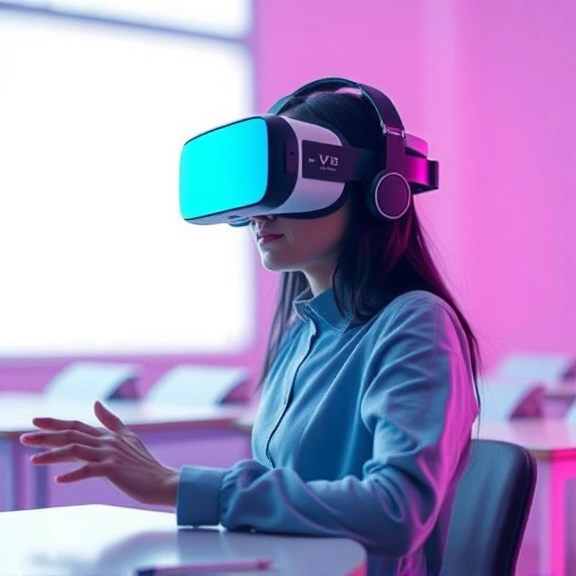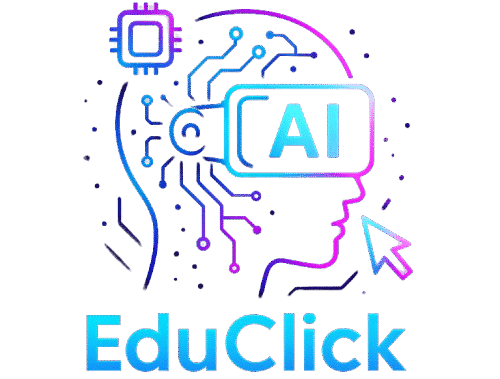Revolutionizing Education: How Virtual Reality is Transforming Classroom Experiences in 2025
Imagine a classroom where the boundaries of space and time are no longer obstacles to learning. As you slip on a virtual reality headset, you’re instantly transported to ancient Rome, standing amidst the grandeur of the Colosseum, or perhaps you find yourself exploring the vast reaches of outer space, glancing back at Earth from the serene silence of the cosmos. This is not a scene from science fiction; this is the classroom of 2025, a place where educational technology trends have taken a giant leap forward, and virtual reality in education has become a pivotal tool.

Whether you are a parent, educator, or student, you understand the value of an engaging learning environment. Remember the times when textbooks were the only window to the world? The endless pages, the black and white diagrams – all seemed like an insurmountable barrier to real understanding. Now, picture a world where those diagrams leap from the pages and come to life within your immediate surroundings. This is the promise of virtual reality in education: to make learning an immersive, interactive, and incredibly engaging experience.
If you are holding on to the nostalgic aroma of printed paper and the rustle of pages turning, the leap into virtual reality might feel daunting. But consider this: technology has always been a gateway to enriching human experience, not just a replacement for existing methods. Perhaps you’ve witnessed the gleam in a child’s eyes as they solve a math puzzle on a tablet or their amazement at a 3D model of the human heart. Virtual reality is merely the next step, a tool to transform those sparks of curiosity into a blazing inferno of knowledge.
Join us on this journey as we explore the transformative power of virtual reality in the classroom. Through detailed examples, case studies, and real-world applications, you will discover how virtual reality is not just a trend but a veritable cornerstone in reshaping how education is delivered in 2025 and beyond.
The Rise of Virtual Reality in Education
Understanding Virtual Reality’s Role in Education
Virtual reality (VR) in education leverages immersive simulation technology to create environments where students can interact with the content more naturally and intuitively. It allows learners to visualize complex concepts, making abstract information tangible and easier to understand. In 2025, VR is not just an auxiliary tool; it is central to modern educational practices.
Case Studies: Schools Embracing VR
Many institutions have already embraced VR technology to create dynamic learning experiences. For instance, a high school in California uses VR to teach biology, allowing students to ‘walk through’ the human body and observe biological processes in real-time. This hands-on experience is far more impactful than traditional methods.
Benefits of VR Over Traditional Methods
- Increased Engagement: VR captures students’ attention, providing an interactive learning platform.
- Enhanced Retention: By experiencing lessons in a 3D environment, students can retain information better.
- Inclusivity: VR can cater to diverse learning needs, making education accessible to students with disabilities.
Transforming Learning Experiences Through VR
Immersive Learning Environments
Virtual reality creates fully immersive environments that transport students to different places and times. Imagine learning about the solar system by navigating through it, experiencing the vastness of space firsthand. This level of immersion helps students comprehend and retain complex concepts.
Real-time Interactivity and Feedback
In VR classrooms, students can interact with simulations in real-time and receive instant feedback. For example, in a VR chemistry lab, students can experiment with chemical reactions without the hazards of a physical lab, learning from trial and error in a safe environment.
Personalized Learning Paths
VR allows for personalized education experiences where lessons can be tailored to meet individual learning speeds and styles. This adaptability ensures that each student receives the attention and resources they need to succeed, making learning a truly personal journey.
🎥 Vídeo complementar sobre o tópico
Current Challenges and Solutions in Implementing VR
Cost and Accessibility
Implementing VR in classrooms can be costly, with equipment and software development being major expenses. However, many schools are seeking partnerships with tech firms and government grants to make VR more accessible. By collaborating creatively, these barriers can be overcome.
Teacher Training and Adaptation
Adapting to new technology can be challenging for educators. Comprehensive training programs are essential to ensure teachers are comfortable and proficient in using VR tools. Workshops and continued professional development opportunities help educators transition smoothly into this new era of teaching.
Technical Limitations
While VR technology is advancing rapidly, technical limitations such as latency and resolution can affect the quality of the experience. Continuous innovation and investment in technology improvements are necessary to overcome these challenges and enhance user experience.
Ethical Considerations and Safety in VR Education
Privacy and Data Security
With the increased use of technology in classrooms, concerns about student data privacy have risen. Educational institutions must implement robust security measures to protect student information and ensure a secure learning environment.
Health Concerns and VR Usage
Extended use of VR can lead to physical discomfort like eye strain and motion sickness. Educators must be aware of these potential health risks and set appropriate usage guidelines to ensure student well-being.
Content Appropriateness
As with any educational material, the content used in VR must be age-appropriate and culturally sensitive. Schools need to carefully vet VR content to align with educational goals and community standards, ensuring it is both safe and suitable for all students.
The Future of Classroom Technology in 2025 and Beyond
Integration with Other Technologies
Beyond VR, classrooms of the future will integrate various technologies like artificial intelligence (AI) and augmented reality (AR) to create a comprehensive educational experience. These technologies will work in tandem to cater to diverse learning needs and preferences.
Advancements in VR Hardware
The future promises more sophisticated VR hardware with improved ergonomics and functionality. Lighter, more comfortable VR headsets with better graphics and longer battery life will become the norm, making the technology more user-friendly and accessible.
Sustainability in Educational Technology
As we advance, sustainability is a key consideration. The educational sector is moving towards green technologies, ensuring that the development and use of VR are environmentally responsible. This includes recycling old equipment and reducing carbon footprints through energy-efficient devices.

FAQ Section
What is virtual reality in education?
Virtual reality in education uses immersive technology to create realistic simulations of different environments, allowing students to interact with and learn from them in a highly engaging way. This method enhances understanding and retention of complex subjects by providing experiential learning opportunities.
How does VR enhance learning experiences?
VR enhances learning by providing immersive experiences that make abstract concepts tangible. It allows students to visualize and interact with content dynamically, offering real-time feedback and customized learning paths, which increase engagement and understanding.
What are the challenges of implementing VR in classrooms?
Challenges include high costs, the need for extensive teacher training, technical limitations, and ensuring content appropriateness. Schools must address these issues through funding, professional development, and collaboration with technology providers to successfully implement VR.
What are the health implications of VR use in education?
Prolonged VR use can lead to physical discomfort such as eye strain and motion sickness. To mitigate these effects, educators should set guidelines for VR usage, incorporate regular breaks, and customize experiences to reduce potential health risks.
How do schools ensure data privacy with VR in education?
Schools ensure data privacy by implementing robust security measures, such as using secure platforms for VR applications and adhering to data protection regulations. Regular audits and updates to security protocols also help maintain the integrity of student information.
What role do teachers play in a VR-enhanced classroom?
Teachers facilitate the integration of VR into the curriculum, guide students through VR experiences, and provide support to help students connect virtual experiences to real-world applications. They are crucial in selecting appropriate VR content and ensuring its effective implementation.
Will VR replace traditional teaching methods?
VR is not intended to replace traditional teaching methods but to complement them. It serves as a tool to enhance learning, providing experiences that are difficult to achieve in a conventional classroom setting, thereby enriching the educational landscape.
What does the future hold for VR in education beyond 2025?
Beyond 2025, VR will likely become more integrated with other educational technologies, such as AI and AR, creating a seamless learning ecosystem. Continued advancements will make VR more affordable and accessible, expanding its use across various educational contexts worldwide.
Conclusion
The journey into the immersive world of virtual reality is only just beginning. As you consider the possibilities, imagine a future where barriers to learning are dismantled and every student has the opportunity to engage with content in the most profound ways. Virtual reality in education is not just about keeping up with educational technology trends; it’s about transforming learning experiences to foster curiosity, understanding, and innovation.
By embracing VR, educators and students alike can redefine educational boundaries and embark on explorative journeys that were once unimaginable. The potential is limitless, and the impact, immeasurable. As schools and institutions adopt these technologies, they pave the way for an educational revolution that will echo across generations.
As you think about the role of technology in education, consider how you can contribute to this movement, whether by supporting local schools in acquiring VR resources or advocating for policy changes that promote technological integration. Engage with teachers, students, and technology experts to understand how VR can be harnessed to its fullest potential.
In this rapidly evolving landscape, your involvement is crucial. Take action today, and be part of the transformative journey that is reshaping education for a brighter, more connected tomorrow.
Key Takeaways
- Virtual reality in education enhances learning by providing immersive, interactive experiences.
- VR is a powerful tool for visualizing complex concepts and promoting student engagement.
- Implementing VR in classrooms presents challenges such as cost and the need for teacher training.
- Ethical considerations, such as data privacy and health concerns, must be addressed to ensure safe VR usage.
- The future of VR in education is promising, with potential for integration with other technologies to create holistic learning environments.




